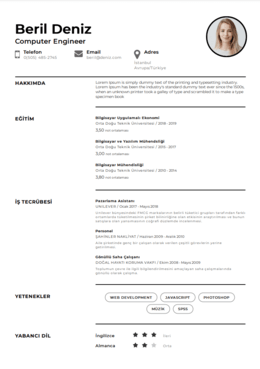Resume Help Zeynep İclal Akçakoca
Resume Styles Best Suited for Your Needs [20+ Tips]
Yeni CV örneklerini inceleThere are many various resume formats to pick from, including:
functional, chronological, or a combination. minimalist or artistic.
Honestly—
If you could send ten different resumes to potential employers so they could choose the one they like most, the world would be a lovely place.
The tragic reality is
You only have one chance.
Additionally, the recruiter will rapidly move on to the next resume from the stack if your preferred resume style doesn't do a wonderful job.
But do not fret.
This piece will demonstrate:
- Employers and recruiters expect professional resume formats.
- How to pick your personal preferred style to increase employment
- Unusual resume variations that could be worth a try.
1. Classic Resume Styles
Let's begin immediately—
Reverse chronological, combination, and functional style resumes are the three standard formats.
Each of these resume formats is appropriate for certain job seekers and situations.
Chronological Resume
The most popular resume format is this one. And with good cause.
A chronological resume structure emphasizes your professional experience and accomplishments, working backwards in time from the most recent. It is simple for recruiters to explore and is parsable by a variety of ATS (Applicant Tracking Systems) applications.
These are the sections of a typical reverse chronological resume:
- career header
- resume objective or a resume summary
- professional title Section of work experience
- Skills
- Additional sections, education
For individuals who have had a steady career advancement, the chronological resume format is an excellent option because it makes it simple to highlight their pertinent accomplishments.
It's appropriate for entry-level individuals without a lengthy work history as well as students. Its conventional resume format and chronological listing are ideal for organizing information in a clear and understandable way.
Functional Resume
The skills-based resume is another name for the functional resume format.
This resume format highlights your professional qualifications. What abilities should you emphasize in a functional resume? Always list the qualifications that are pertinent to the role.
But—
The abilities you have should not be the main focus of your functional style resume. Instead, pick the best ones, then center your CV on those.
Typical functional resume sections include the following:
- career header
- profile resume
- skills overview
- Section on additional skills
- Career Background Education
This format is ideal for creatives who need to have a portfolio of their work, transitioning service members writing their military to civilian resumes, and job seekers who don't want to appear overqualified.
After that,
The recruiters don't like this resume format. Why? It is more difficult to scan than a chronological résumé. Additionally, the ATS might have trouble processing it.
Combination Resume
The combination resume format, as its name implies, combines the best components of the two previous resume formats and emphasizes both your experience and your skills.
A typical combination resume, often known as a hybrid resume, has the following sections:
- Contact details
- skills overview
- Added abilities
- professional background/position description
- Education
- The sequence of the resume sections can be changed to meet your demands because it is a very flexible resume format.
Candidates with a lot of experience who are applying for specialized roles should use this style of resume. It's beneficial for those who wish to draw recruiters' attention away from employment gaps as well as those who are changing careers.
If you choose to use this resume format, you should be aware that it could be difficult to get it quite right.
2. New Resume Styles
The employment market is more competitive than ever since more and more people are joining the workforce.
It makes sense that candidates will seek out novel means of attracting attention.
One strategy for getting the hiring manager's attention on your resume is to experiment with resume formats.
When submitting resumes for employment in creative fields, modern resume formats might make you stand out.
Be mindful, though.
It's not always a good thing to have too much of a good thing.
Make sure the resume you choose adheres to the company's culture and the position you are applying for.
Creative Resume Styles
Creativity has no boundaries.
In light of this, a creative resume style could be a tiny addition you make to a conventional resume (such as a rating scale for your skills) or a resume that includes a unique graphic element that fills the entire page.
Browse through our collection of unique resume templates to acquire ideas, then select the design that appeals to you.
Pro tip: Creative resume formats could also have extra parts that aren't present in standard resume formats. or the complete opposite. Some portions might be entirely omitted and replaced with irregular components.
Visual Resume Styles
According to resume science, a recruiter will scan your paper for approximately 6 seconds.
What better way to catch the recruiter's attention than with a visually appealing resume?
To transform your resume into a mini work of art, experiment with the font types, font sizes, white space, headings, and even the resume paper.
Bear in mind, though—
Don't allow the visuals overshadow the information on your resume. Your resume's aesthetics should support its substance. not to be replaced
You may get started by browsing our selection of graphic resume templates in our collection.
Infographic Resume Styles
Infographics have become extremely popular online.
And to be honest, it doesn't really surprise me.
Why?
They look fantastic and are also quite educational.
similar to how a strong resume should.
This kind of résumé will undoubtedly catch the recruiter's eye. Send graphical resume formats right to the hiring manager's email because they will almost probably not pass the ATS screening.
Also, if you need inspiration, visit our hand-picked collection of the top infographic resume templates on the web.
Pro tip: Make sure your cover letter and resume are written in the same format.
3. Resume Styles by Length
Your resume's style could mean a variety of things.
The length of a resume is one of the factors that most often sets one from another.
One-page Resume Style
How far back a resume should go has been a topic of much discussion, and it appears that there is no one optimum answer.
Having said that, there are advantages to a one-page resume format.
One reason is that second pages frequently disappear. Fitting everything you need on a single page is the greatest method to prevent incomplete resumes.
Additionally, a recruiter will find a one-page resume to be lot more approachable.
Just consider—
An average job offer generates 250 applications. It can be difficult to read them all, especially if each résumé takes up more than one page.
Check out our selection of one-page resume templates if you find this resume format attractive.
Making a two-column resume is one of the finest ways to fit more information on a single page without having it look cluttered.
Two-page Resume Style
A two-page résumé is still common.
In fact, you might have a valid rationale for choosing this resume format, such as—
enormous experience
What other justification could there be for your resume to be two pages long if this one?
Plus—
This study found that more than 77% of employers anticipate a seasoned worker's CV to be at least two pages long.
Pro tip: Check out our resume writing advice and make sure your resume doesn't contain any of the common problems found in resumes.
4. Current Resume Styles
The problem is this
Every trend is cyclical.
The most popular resume formats of today will be outdated by tomorrow.
Let's look at a few professional resume formats that have recently become very popular, keeping this in mind.
Minimalist Resume Style
Over the past few years, the less is more guiding idea has gained popularity.
Actually, it's the kind of fashion that might last a little while longer.
Business-style resumes and bullet-style resumes both favor the minimalist look.
This type of resume places a complete emphasis on content and scannability.
Look through our collection of simple resume templates and choose your favorite.
Simple Resume Format
As was already stated, the most popular design trend at the moment is simplicity.
It's hardly surprising that applicants from all different backgrounds prefer basic resume formats.
A straightforward CV is not simplistic. Since simplicity is the pinnacle of sophistication.
This may help to explain why adornment is purposefully left out of so many executive-style resumes in favor of simplicity and clarity. Long paragraphs are far less clear than well-structured, legible bullet points with plenty of white space surrounding them.
Visit our gallery to choose the greatest simple resume template for you if you're looking for one.
Basic Resume Style
Students and entry-level candidates who may not have much work experience or a lengthy employment history yet don't want to stuff their applications with unnecessary information should choose basic resume formats.
Actually, anyone who wants to concentrate on the content should use a basic resume style.
After that,
Your simple resume doesn't have to be monotonous in the slightest.
Choose the blank resume form or template that appeals to you the best from our collection.
Additionally, a strong cover letter that complements your CV will set you apart from other applicants. You can create one using this cover letter builder. Here's what it might resemble:
Key Takeaways
All you need to know about resume formats is this:
- The chronological, functional, and combination resume types are the most widely used traditional resume formats.
- Creative resume formats, infographic resumes, minimalist resumes, and basic resumes are a few of the newest resume designs.
- The length of the paper is another way to group resume formats.
- Always ensure that the resume format you select suits the requirements of the position (traditional vs. current) as well as the workplace culture.
- The format of the resume is not the only factor to consider. Make sure your resume is customized for the job offer.
- Additionally, don't forget to select a complementary style for your cover letter.
Unsure of the best resume format to use? Please mention us in the comments section below. always willing to assist.
















































